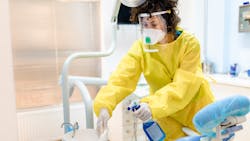Infection control review: Common oversights from three perspectives
Editor’s note: Content shared in this article are guidelines and recommendations from the Centers for Disease Control and Prevention and the Organization for Safety, Asepsis and Prevention. This is part one of a series. Read part two here.
Infection control can be viewed by the dental hygienist as an action that is as simple as breathing air. After a while, performing infection control becomes second nature. How often do we stop and really dissect infection control from different viewpoints? Let’s cast aside the analytical part of ourselves and focus on our end goal. When we stop constantly assessing and fully immerse ourselves in others’ viewpoints with an open mind, we allow ourselves to fully understand perspectives.
Staying compliant and committed to infection control in 2022
Teledentistry: The infection control protocol you didn't know you needed
This viewpoint is so critical when it comes to infection control because it is not just our task at hand that needs to be in the forefront of our decision; it’s through the viewpoints of others that we can truly assess whether our game is on point. We will discuss multiple viewpoints of infection control and common oversights that are made. Every viewpoint is from someone or something that will directly be impacted if infection control is not carried out correctly. Our first and foremost viewpoint is that of our patients.
Patients: The other set of eyes
Our patients observe more than we may expect. The ongoing COVID-19 pandemic increases the health and safety concerns with the things our patients experience or notice. Patients want to know that we have made their dental appointments as safe as possible. What do they expect and observe at their dental appointments?
During the appointment
The dental waiting room has become a thing of the past. No longer can patients get caught up with the latest fan magazine, chit-chat with the front desk personnel, or sip coffee while waiting to be called back. They may notice plexiglass barriers separating them from the receptionist, hand sanitizer readily available, and a more austere environment devoid of high-touch objects on the tabletops. Patients will experience minimal time in the waiting room and be escorted back to the disinfected operatory after their temperatures are taken and recorded.
The operatory may look different from how it did the last time the patient was there. Barriers will be in place that cover exposed computer keyboards, chairs, and equipment. Just as in the reception room, a limited number of items will cover the counters—only those necessary for the procedure. Infection control visual alerts and notices are frequently placed in full view for all to read. These posted messages provide instructions for hand hygiene, respiratory hygiene, and cough etiquette. Patients are acquainted with seeing us in masks and gloves, but to them we may appear like something out of a space movie. Full-face shields, goggles, complete-coverage overgowns, and N95 respirators are the now new standard personal protective equipment (PPE) for dental treatment.
The addition of HEPA–filtration devices, improved office airflow, and increased use of high-volume evacuators (HVE) enhance aerosol control in the operatory. The rubber dam and intraoral suction and retraction units may be a new and awkward experience for patients during procedures. These additional precautions further protect dental clinicians and patients during treatment.
Following the appointment
Patients will view expanded cleaning and disinfection measures as their treatment is completed and they are escorted out of the office. Many offices use teledentistry, electronic payment, and rescheduling systems to decrease patients’ extra time in the office.
Before, during, and after dental procedures, health and safety concerns are essential for our patients. We need to be aware of patient concerns, questions, and observations. We must reassure them that we take every opportunity to safeguard them and ourselves from the spread of disease.
Dental hygienist: The meticulous eye
It could be a stereotype or a personality trait, but dental hygienists are meticulous by nature. The American Dental Education Association (ADEA) lists typical characteristics of a dental hygienist as positive, passionate, and detail oriented.1 When challenged with upping the infection control game, this attention to detail benefits the entire dental team as well as our patients.
In the 1980s, when stricter infection controls were being put in place spurred by the HIV/AIDS epidemic, dental hygienists were on board. Since then, we have continued to comply with specific safeguards and infection control procedures. As licensed dental hygienists, we are responsible for maintaining the highest standards of infection control within our clinical practice to guarantee that our patients and coworkers are healthy and safe.
The American Dental Hygienists’ Association (ADHA) recommends that “all dental hygienists follow the Standards for Clinical Dental Hygiene Practice, which states that dental hygienists follow the most current guidelines to reduce the risks of health-care-associated infections in patients and illnesses and injuries in health care personnel.”2 Dental personnel involved in direct patient care should follow Standard Precautions set forth by the Centers for Disease Control and Prevention (CDC). Positive, passionate, and detail-oriented dental hygienists should review the standard precautions and lead the dental team by example. They can also take point and become the infection control coordinator for the office.
Infection control coordinators: The observant eyes
Our dental offices are fast-moving medical settings with many moving members. Office team members must be consistently on the same page to understand and follow infection control protocols and policies. To properly sustain order and compliance to infection control, each office should have at least one person in charge of the infection control program—the infection control coordinator (ICC).
The ICC will initially review and evaluate the office’s written infection prevention program and procedures set in place to protect patients and keep employees safe. During the operating times of a dental office, the ICC will observe and monitor all aspects of infection control and all team members’ compliance to the program for that office. Following the observation and evaluation, the ICC educates team members on CDC–recommended infection control procedures and mandated Occupational Safety and Health Administration (OSHA) training. Training should include techniques to prevent exposure to infectious pathogens, information and guidance regarding the office’s exposure control plan, appropriate sterilization protocol, and conformity to current PPE recommendations, including proper donning and doffing. Observation and evaluation of hand hygiene compliance, environmental surface disinfection, and oversight of sterilization practices are additional responsibilities of the ICC.
Where do we sometimes fall short in this position? Assumption that everyone understands the same level of infection control, not being able to manage the gap with fellow colleagues due to office dynamics, having a passive employer who does not back the infection control initiative, not keeping up-to-date records, and lack of attention to the level of importance of the ICC role are some shortcomings that can start a ripple effect of poor infection control measures within the practice.
The ICC plays a vital role in observing and modeling the highest level of infection control competency. This high level of competency and commitment to the overall safety and health of the dental team and patients should be the responsibility of all dental office members.
Keeping up on another viewpoint that is often overlooked—the equipment—is another task of the ICC. In the next part of this article, we will be discussing the infection control perception from the equipment, dental product purchaser, and business owner’s points of view. We will also list the top infection control infractions seen on inspections.
Editor's note: This article appeared in the July 2022 print edition of RDH magazine. Dental hygienists in North America are eligible for a complimentary print subscription. Sign up here.
References
- Common traits of a dental hygienist. American Dental Education Association. https://www.adea.org/GoDental/Future_Dental_Hygienists/Common_traits_of_a_dental_hygienist.aspx
- ADHA interim guidance for dental hygiene practice during the COVID-19 pandemic. American Dental Hygienists’ Association. August 5, 2020. Accessed January 7, 2022. https://www.adha.org/adha-interim-guidance
About the Author

Maryanne Ferree, BS, RDH, PHDHP
Maryanne Ferree, BS, RDH, PHDHP, is a registered dental hygienist with more than 35 years of experience. She has ventured into many facets of dental hygiene, including clinical care, public health, and education. She enjoys teaching the next generations of dental students at the University of Pittsburgh, School of Dental Medicine. Ferree has been excited to step into the role of key opinion leader and blogger to share her enthusiasm for all things infection control. She continues to advance her education by finishing the last year of her MPH and focusing on infectious disease and microbiology. She can be reached at [email protected].
Updated October 25, 2021

Nicole Giesey, MBA, MSTPE, BSDH, RDH
Nicole Giesey, MBA, MSPTE, BSDH, RDH, is dedicated to researching, writing, and helping people in general through her current platform. She began her career as a dental assistant and then progressed into dental hygiene, then branching into dental hygiene education. With the opportunity to get into dental product management knocking at her door, she leaped into the world of dental sales. She is now a dental product sales representative and can be reached at [email protected].
Updated September 9, 2021
